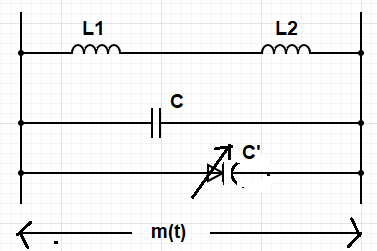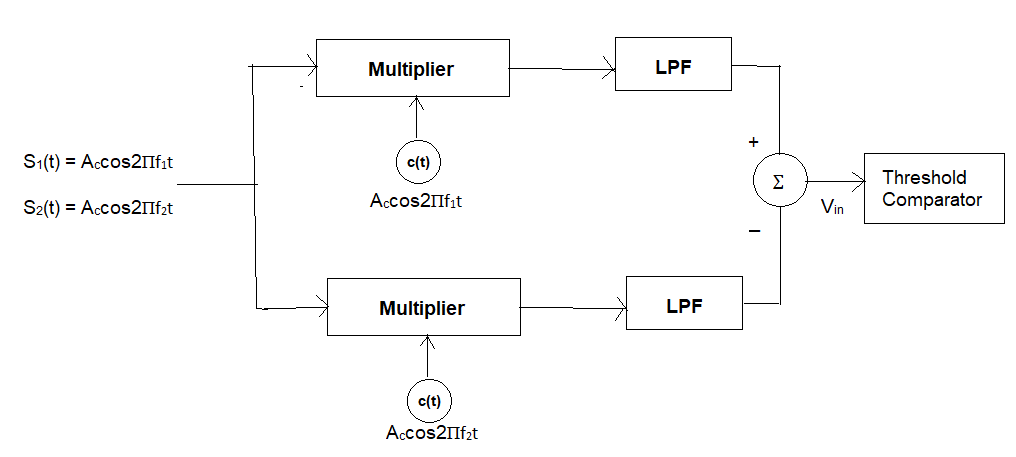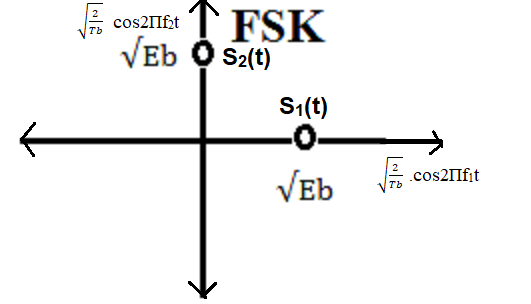Amplitude shift keying, Frequency Shift Keying, Binary Phase Shift Keying: Generation and Detection
Frequency Shift Keying (FSK)
Theory:
Frequency-Shift Keying (FSK) is a frequency modulation scheme in which digital information is transmitted through discrete frequency changes of a carrier wave. The simplest form of FSK is Binary FSK (BFSK), which uses a pair of discrete frequencies to transmit binary (0s and 1s) information. With this scheme, the frequency representing a "1" is called the mark frequency (f1) and the frequency representing a "0" is called the space frequency (f2). If the incoming bit is 1, a signal with frequency f1 is sent for the duration of the bit. If the bit is 0, a signal with frequency f2 is sent for the duration of this bit. This is the basic principle behind FSK modulation.
FSK Transmitter:
In this binary scheme, '1' is represented by a higher frequency carrier (say, f1) and binary '0' by a lower frequency carrier (say, f2).

VCO (Voltage Controlled Oscillator):

The output frequency (fi) of the LC tank circuit in the VCO
is given by:
fi = 1 / (2П√((L1+L2)(C+C')) )
FSK Receiver:
The figure below illustrates a coherent FSK receiver. This type of receiver uses two correlators, each matched to one of the possible FSK frequencies (f1 for binary '1' and f2 for binary '0').

The received FSK signal, r(t), is fed into both branches of the receiver. Each branch mixes r(t) with its respective local carrier (e.g., cos(2Пf1t) or cos(2Пf2t)) and then integrates the product over the bit duration Tb.
Let's denote the output of the upper correlator (matched to f1) as Y1 and the output of the lower correlator (matched to f2) as Y2.
-
If binary '1' (Accos(2Пf1t)) was transmitted:
- Y1 will have a significant positive value (proportional to Eb).
- Y2 will be close to zero, assuming f1 and f2 are orthogonal over Tb.
-
If binary '0' (Accos(2Пf2t)) was transmitted:
- Y1 will be close to zero.
- Y2 will have a significant positive value (proportional to Eb).
The difference between these two correlator outputs, Y1 - Y2, is then fed to a threshold comparator.
- If Y1 - Y2 > 0 (or a threshold close to 0), the receiver decides '1'.
- If Y1 - Y2 < 0 (or a threshold close to 0), the receiver decides '0'.
In an ideal scenario with no noise and perfectly orthogonal frequencies:
- If '1' is sent, Y1 ≈ Eb and Y2
≈ 0, so the difference is Eb.
- If '0' is sent, Y1 ≈ 0 and Y2 ≈
Eb, so the difference is -Eb.
The optimal decision threshold for binary FSK in AWGN is typically 0 V.
Constellation Diagram of FSK

Figure: Constellation diagram of FSK
In the above figure, the points are plotted in terms of the coordinates
along the two orthogonal basis functions.
The distance between signaling points, d12 = √( (√(Eb)
- 0)2 + (0 - √(Eb))2 ) = √(Eb
+ Eb) = √(2Eb).
Due to the orthogonality of the basis functions, the signal points in
the constellation diagram lie on perpendicular axes, forming a
90-degree angle between their vector representations.
High-order frequency shift keying (FSK) refers to using a larger number
of frequency shifts to represent multiple symbols or bits of digital
data. In FSK, each frequency represents a unique symbol or set of bits.
High-order FSK schemes enable higher data rates but can also be more
susceptible to noise and channel impairments.
Under different noise configurations
FSK Modulation with AWGN:
In FSK modulation, digital data is represented by varying the frequency
of the carrier signal. Let's consider a basic case of binary FSK with
two different carrier frequencies f1 and f2,
corresponding to the two binary symbols.
Mathematically, the FSK-modulated signal x(t) can be represented as:
x(t) = Accos(2Пf1t), { for binary symbol 1}
x(t) = Accos(2Пf2t), { for binary symbol 0}
In the presence of AWGN, the received signal y(t) becomes:
y(t) = x(t) + n(t)
Where:
x(t) is the FSK-modulated signal.
n(t) is the AWGN.
The AWGN introduces noise across all frequencies, affecting both the
amplitudes and phases of the signal components. Since FSK relies on
frequency differences for symbol differentiation, the noise can cause
frequency shifts and amplitude variations, leading to errors in
demodulation. The impact of noise can be quantified using the SNR
(signal-to-noise ratio).
FSK Modulation with Rayleigh Fading:
Rayleigh fading, as discussed previously, introduces random amplitude
and phase variations to the received signal due to multipath
propagation. In the case of FSK modulation, the mathematical
representation of the received signal y(t) under Rayleigh fading is:
y(t) = h . x(t) + n(t)
Where:
h is the complex fading coefficient.
x(t) is the FSK-modulated signal.
n(t) is the noise.
The fading coefficient h introduces random variations in both amplitude
and phase to the signal components. As a result, the amplitudes and
phases of the two carrier frequencies can experience fluctuations due to
fading, potentially causing errors in symbol detection.
FSK modulation under different noise configurations involves adding
noise to the modulated signal. AWGN introduces amplitude and phase noise
across all frequencies, affecting the differentiation between FSK
symbols. Rayleigh fading introduces random amplitude and phase
variations due to multipath propagation, impacting the signal's
components. In both cases, the reliability of FSK demodulation depends
on the SNR for AWGN and the characteristics of the fading channel for
Rayleigh fading.
